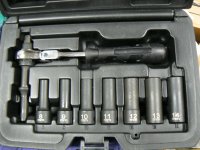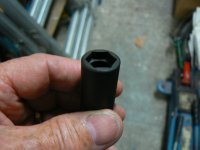over the last 10 years and more so in the last couple, I have found buying tools really addictive!
I went from never having the right tool for the job, having to make do, borrow [not a fan of that]
Nowadays, if I plan to do a job on my car and I know that I will need a special tool, I try to buy it in advance, I dont spend a lot and I have learned on occasion that if you buy cheap, you buy twice.
Sometimes the new tool has never needed to be used, thats just how it goes isnt it.
mrs keeps tutting when a new parcel arrives! but when she buys her crafting stuff so do I!
my most recent job, has meant I have needed to buy an Injector Seal Remover tool, and an injector seat reamer.
I think back to the first half decent tools I bought, I was probably about 20 and had been driving for nearly 3 years, my Dads tools werent up to much [he fixed his own cars too] and he didnt like me borrowing them, I bought a Halfords 20 piece 1/2" drive socket set, it wasnt much but it made a world of difference, I still have the ratchet! its outlasted lots, and some were far better makes!
So anyway, who else likes buying tools?
oh yes, I try my hardest NOT to borrow anything, and I try not to lend my tools out to anyone else, we have all been there havent we! by all means come here and use my tools, and I will even help, but I know that as soon as it goes out, it may never come back and if it does, sometimes not right or parts missing! or I will need it and cant get it back.
I went from never having the right tool for the job, having to make do, borrow [not a fan of that]
Nowadays, if I plan to do a job on my car and I know that I will need a special tool, I try to buy it in advance, I dont spend a lot and I have learned on occasion that if you buy cheap, you buy twice.
Sometimes the new tool has never needed to be used, thats just how it goes isnt it.
mrs keeps tutting when a new parcel arrives! but when she buys her crafting stuff so do I!
my most recent job, has meant I have needed to buy an Injector Seal Remover tool, and an injector seat reamer.
I think back to the first half decent tools I bought, I was probably about 20 and had been driving for nearly 3 years, my Dads tools werent up to much [he fixed his own cars too] and he didnt like me borrowing them, I bought a Halfords 20 piece 1/2" drive socket set, it wasnt much but it made a world of difference, I still have the ratchet! its outlasted lots, and some were far better makes!
So anyway, who else likes buying tools?
oh yes, I try my hardest NOT to borrow anything, and I try not to lend my tools out to anyone else, we have all been there havent we! by all means come here and use my tools, and I will even help, but I know that as soon as it goes out, it may never come back and if it does, sometimes not right or parts missing! or I will need it and cant get it back.






